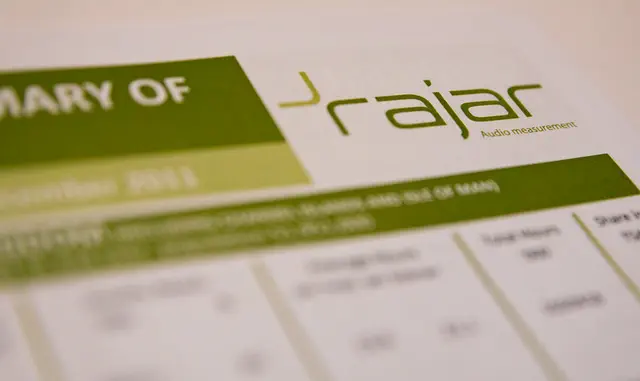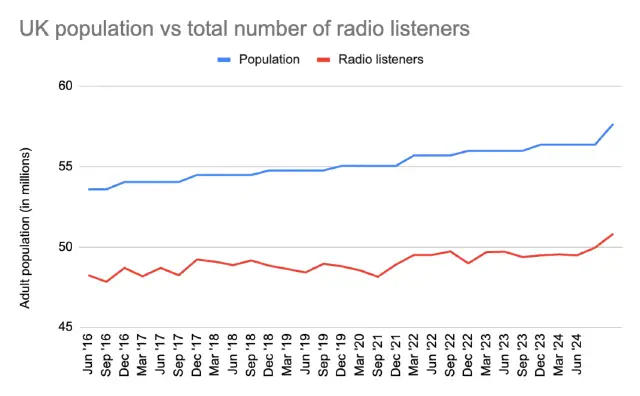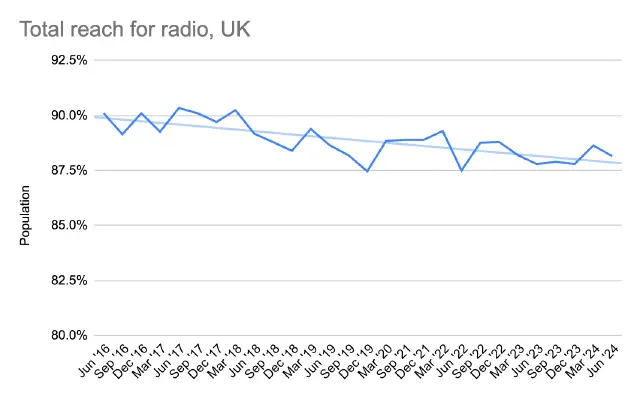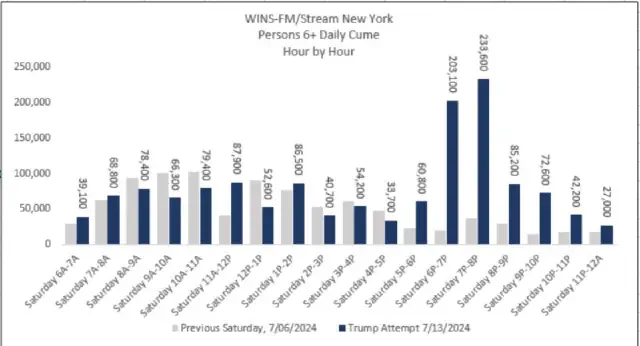A tale of two statistics

In the UK, the RAJAR radio listening figures were released for Q2/2024.
RAJAR talks to around 100,000 people a year, and asks them what radio station they listened to, as well as where (at home? in the car?) and how (FM? DAB? Online?). It uses both a paper diary looking like this, but also an online equivalent, as well as 5,000 people with MediaCell, an mobile phone app that listens to everything.
RAJAR takes that information and “weights” it to the total population - matching the results of each demographic group to its correct proportion in the area. (As a very basic example, if they interview 55,000 women and 45,000 men, the data would be multiplied up to match the UK population, which is 51% women and 49% men. In fact, they do this for each individual area of the country, and for all kinds of demographic data).
Why should you care? Well, it’s because the total population in the RAJAR figures is always updated every Q2; and this year, it includes data from the 2021 Census, so it’s changed quite a lot. Particularly, Q2’s data says that there are now 1.3mn more adults than there were in Q1.
More population means sample-based data like RAJAR will return bigger numbers, irrespective of what they’re measuring. So, yes, radio listening is up - a record 50 million people in the UK listening to radio.

But also, radio’s number of listeners actually down. Just 88.1% of the population is listening this time around; down from 88.6% of the (smaller) population in Q1.

As ever, there are two stories to be told from this data. Yes, more people than ever before are listening to the radio; and also radio’s total number of listeners, as a percentage of the population, has gone down, not up.
But actually, UK radio did celebrate a record this quarter - and it’s a rather more impressive one.
Total hours is up; and the average radio listener now listens to 20.6 hours of radio a week. That is the highest figure for five years. A much more impressve figure, if you ask me, than total audience - because that’s all radio’s hard work paying off.
PS: You’ll see a trend line above for the percentage reach. It’s very bad maths to follow that trend linearly. But let’s do it anyway. If radio continues this trend, nobody at all will be listening in 2355. That’s more than 300 years away.
(The main RAJAR image above is from Adam Bowie who has covered this quarter in much more detail.)
The amount of ads in podcasts has increased by 20% year-on-year. So says data from Magellan AI. The average ad-load is 7.19% (equivalent to 4.3 minutes in an hour). I wondered how that compared with radio, so I listened to WCBS-FM’s breakfast show last week and discovered that 24.1% of it was ads (14.5mn an hour). Even NPR’s Morning Edition, as aired on WBEZ Chicago, was 7.3% (4.4mn per hour): so podcasts carry much less advertising content than broadcast radio. This will be seen as an opportunity by podcast publishers, perhaps, to increase ad-load further; but I’d suggest it should be seen as an opportunity to control yield.
The BBC released Q2/24 data on its BBC Sounds app: total plays are down 5.5% on the quarter (vs Q1), and it’s also seen a 2% drop in weekly audience. The better news is that the BBC posted 3% higher podcast downloads via open RSS, to 209mn. (Your own app is for your super-fan).

John Snyder from Nielsen posted the above graph on LinkedIn - showing audience figures for WINS, the news station in NYC, the weekend Trump was shot (compared to the previous weekend). Quite an impressive graph - and impressive to see it shared.
Want to hear the BBC World Service station sound? Here’s the current set of audio from Mcasso. A consistent sound for a radio station is massively important - try “Main theme”, “Newsday”, “Business Daily”, and “Business Matters” in that order, to hear the consistent rhythm most clearly. I preferred the David Lowe era - but the consistency is still clear to hear.
I was at NPR in 2009, giving a talk about radio’s future (which I enjoyed doing). I’m quite excited that I’ll be back in/near Washington DC in a few weeks, at Podcast Movement - and have managed to get a visit to the “new” NPR headquarters on the Monday. Fun! (If you want tickets to Podcast Movement, use the code
PODNEWSand get some money off).
Thank you to Radio King who have become my latest supporter for this newsletter. Radio King offers everything you need to make your own internet radio station, including apps and smart-speaker skills. Supporters like Radio King mean I can justify spending a little longer on this newsletter each week; I’m always grateful for feedback, too.
- Want to supercharge your radio show? Here’s a £1 week-long trial of Show Prep - from a world class radio consultant and the best show-prep writer in the UK. Great for UK stations, or for English-language stations everywhere, too. (ad)
Where I am speaking next
- Podcast Movement, Washington DC (Aug 19-23)
- Radiodays Asia, Kuala Lumpur (Sep 2-4)
- PBI Conference, Ottawa, Canada (Oct 8-10)
- Lyddager, Norway (Oct 18-19)
- Guldörat, Sweden (Oct 22)
- Independent Podcast Awards, London (Oct 23)
- Audiodays, Denmark (Oct 25)
- ASI International Radio & Audio Conference, Venice, Italy (Nov 6)
- Radiodays Europe, Athens, Greece (Mar 9-11 2025)
Supporters
Thank you to the supporters you see on this site, plus Richard Hilton, Emma Gibbs, Jocelyn Abbey and James Masterton for being regular supporters.
If you’d like to support my work in any way, you can BuyMeACoffee - become a member to give regularly or just give a one-off coffee, or five. Here’s where to do that.
Please do follow me on Mastodon, too: I’m @james@bne.social there. I’m much more active there than anywhere else.
My website has more detail about who I am, and what I do, and whether I can help you further.
My newsletter is supported by:
Selected bits from Radioland are in RadioInfo in Australia, and RAIN News in the US
Lesen Sie außerdem ausgewählte Artikel auf Deutsch in Radioszene
